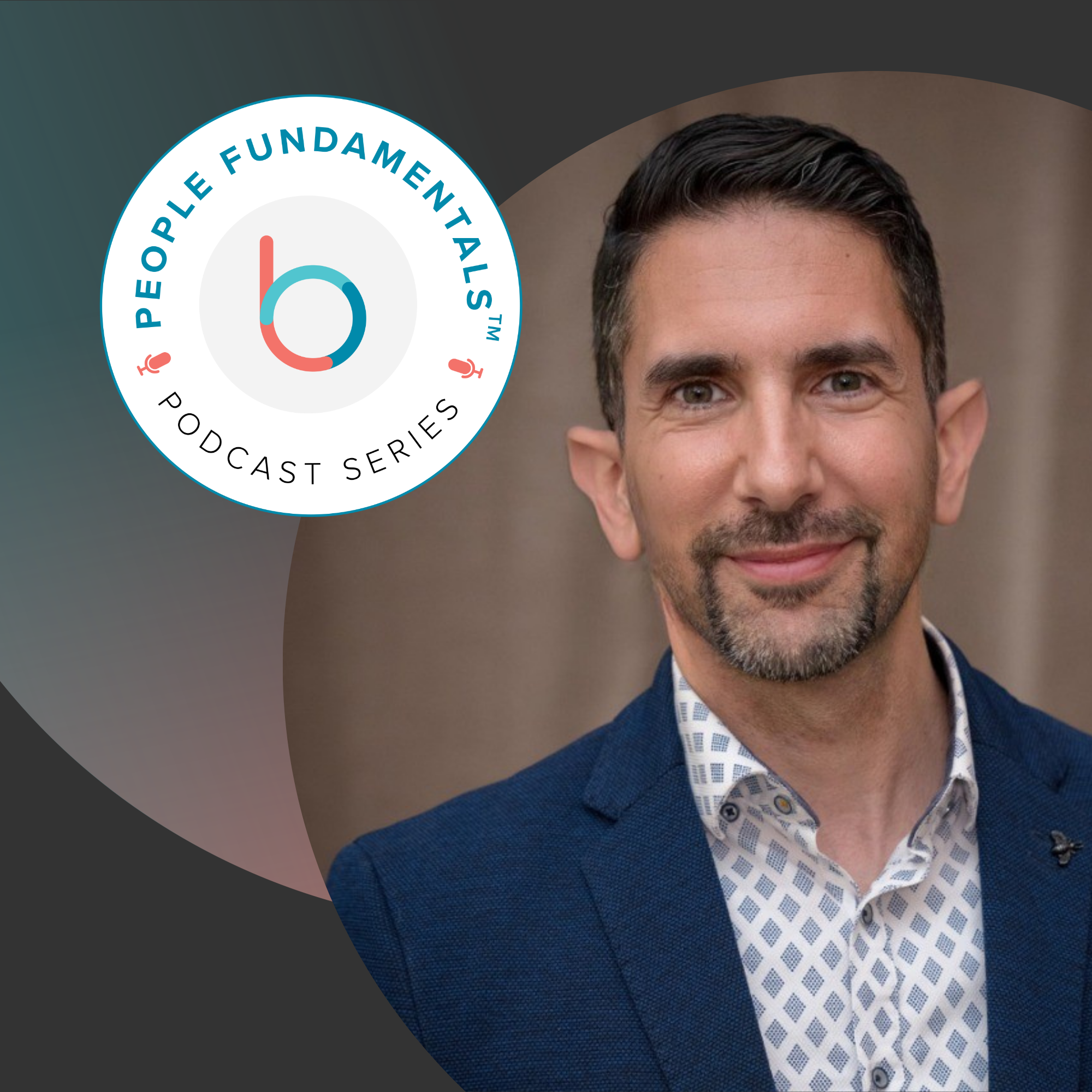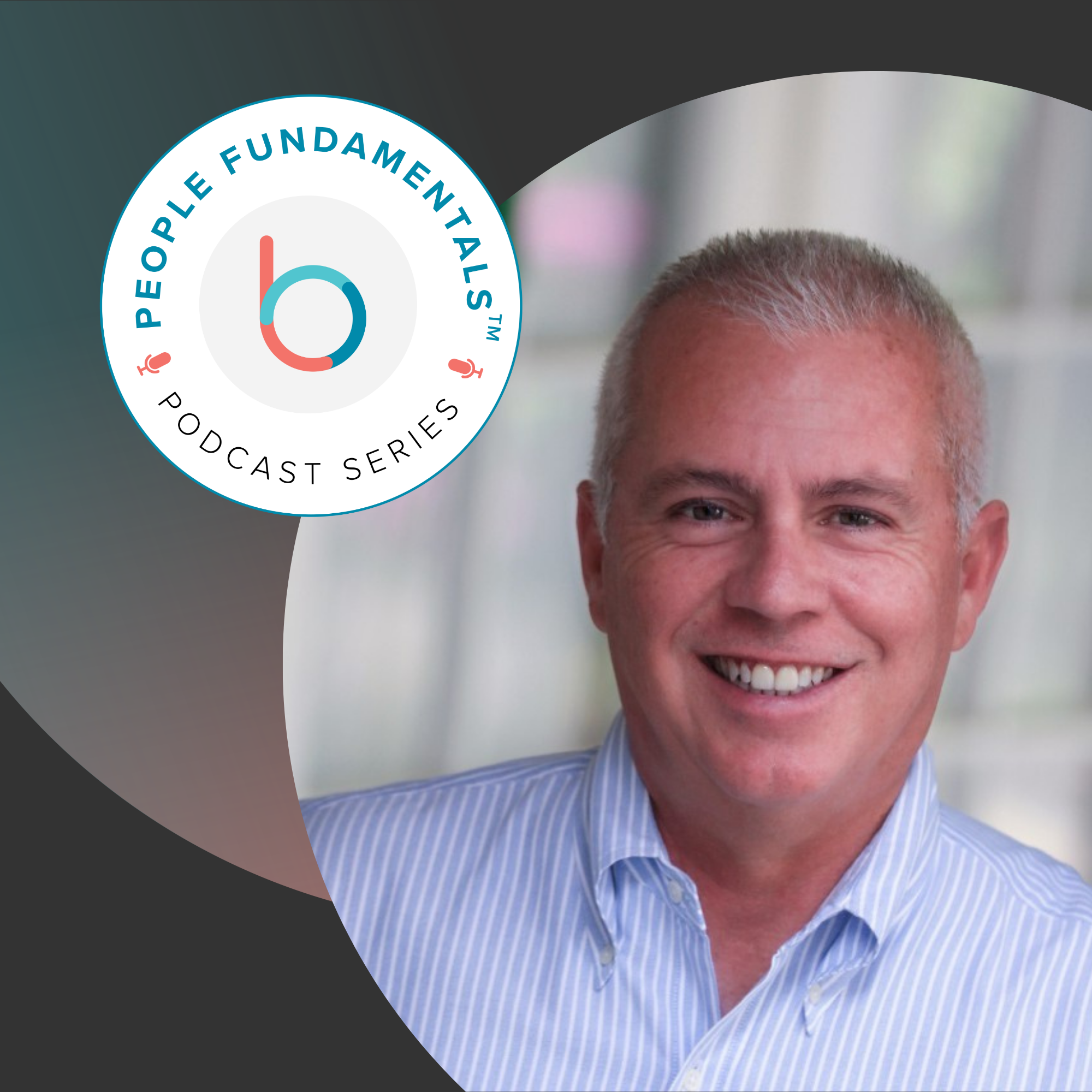Trust is foundational to every prosperous human relationship, whether personal, societal, or in the workplace. At work, high levels of trust generate engagement, productivity, discretionary effort, team cohesion, a greater sense of purpose, and commitment to the goals and values of an organization. Researchers have shown that high-trust companies have 50% higher productivity and happier employees.
Yet, we are facing a crisis of trust in today’s workplaces. The very thing we need to function properly eludes us. Data from Gallup, RedThread Research, and our 2023 State of Performance Enablement survey show low trust in leaders, organizations, and HR. According to Betterworks’ research, 32% of employees trust their organization’s leadership and 26% trust HR. (Thankfully, trust in managers and peers is far higher.) Recently released research from RedThread reveals that only 46% believe their organizations have developed a culture of trust.
What can you do to close the trust gap?
Fairness matters most in building trust
The most critical element driving trust in the employee experience is a sense of fairness, according to Betterworks research, with 55% of those surveyed citing it as the most critical factor. Fairness includes concepts of equity (in both pay and access to opportunities), inclusion, the absence of bias, and employees’ expectation that their employers will deliver on their promises.
What we also discovered in our latest ebook, Focusing on Fairness to Close the Trust Gap — is that success in performance management correlates with high levels of fairness and trust across the organization. When employees view performance management as a success, trust in leaders and HR increases by 4x and trust in managers doubles compared to employees who see performance management as a failure.
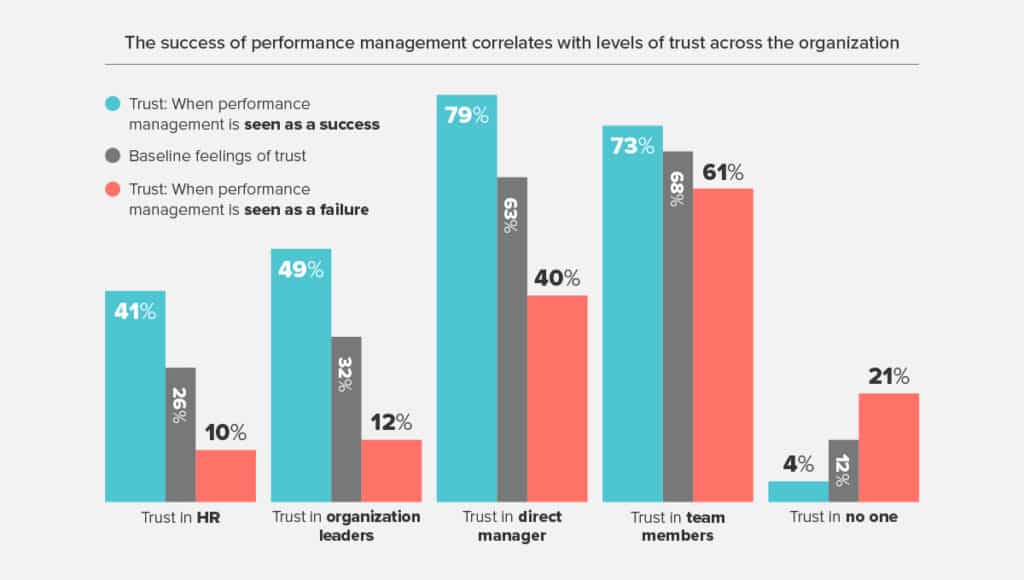
While there are many factors impacting organizational trust, it is clear that having the right performance management processes and the right technology to support those activities is essential to strengthening trust and reaping the bottom-line benefits of a high-trust culture.
How modern performance management drives trust
Let’s first start with the right definition of performance management. When organizations deploy modern what we call “performance enablement” or “Intelligent Performance Management,” trust can flourish. This is not traditional performance management — the backward-looking and universally despised compliance-driven process that involves once- or twice-a-year performance reviews and is accompanied by a yearly calibration process often based on a 9-box or 6-box model for ranking and rewarding employees.
More and more forward-thinking organizations have abandoned this outdated practice. They recognize that modern performance management is a continuous and forward-focused process of employee enablement. It keeps everyone aligned on the most strategic business goals. It promotes frequent manager-employee conversations and peer feedback to quickly troubleshoot, remove roadblocks, and reinforce positive behaviors and actions.
Successful performance enablement strengthens trust precisely because it reduces bias, is inclusive, and is a set of practices that recognizes and rewards employees for their contributions. The correct performance enablement processes and technology have a multiplier effect, promoting autonomy, transparency, responsibility, a sense of belonging and inclusion, and other positive sentiments. They encourage frequent and clear communication and collaboration. Employees establish meaningful goals and measurable results that align with team goals and can be adjusted when needed to reflect the continually evolving needs of the business. In this way, performance enablement can improve organizational culture.
Intelligent Performance Management enables organizations to gain insights from the rich structured and unstructured data collected in the performance enablement solution to develop a holistic and comprehensive view of an employee’s accomplishments. It goes a step further, using AI as a co-pilot to summarize that data and help managers write unbiased and accurate performance reviews while still preserving the role of human insight and manager control.
Eliminating bias in performance reviews closes the trust gap
RedThread’s recent research points to the need to focus on reducing bias in performance management practices: 60% believe their managers provide them with fair and accurate feedback, and 42% believe their organization provides defined criteria and resources to reduce assessment bias.
“It’s important to understand that there is much work to be done here when it comes to fairness,” says Stacia Garr, co-founder and principal analyst at RedThread Research. (Watch her survey presentation at HR Tech.)
Unfortunately, the performance review often suffers from conscious or unconscious biases, such as recency bias, affinity bias, or the halo and horns effect. Betterworks’ 2023 research revealed that only 30% of employees feel performance reviews are “very fair and equitable,” 37% feel they are “somewhat fair and equitable,” and a quarter believe they are biased (another 8% “don’t know”).
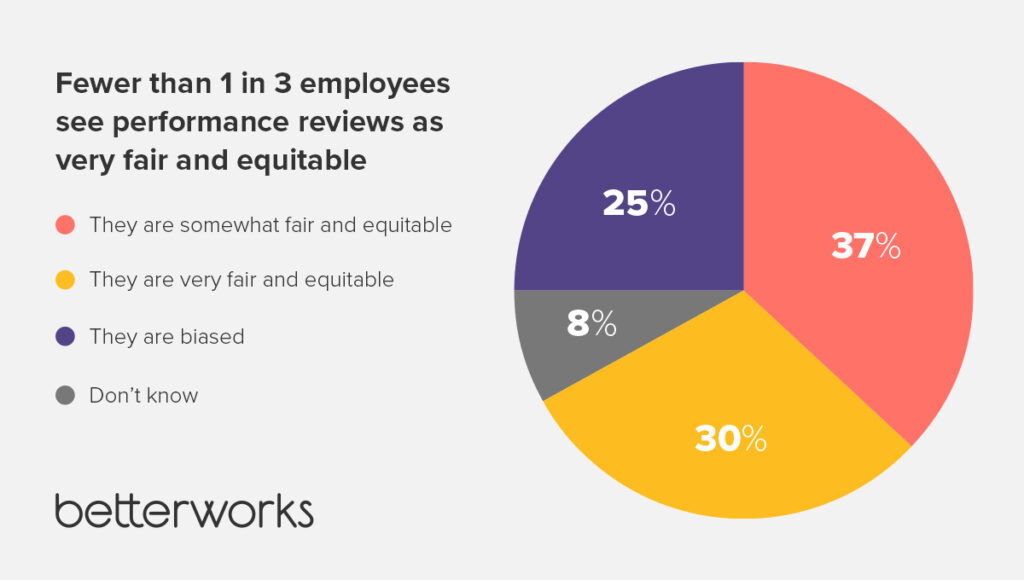
If 62% of your employees feel that your judgment of their performance — the accumulation of all their efforts — is somewhat or very biased, how can your organization expect to have an engaged and productive workforce committed to helping achieve organizational goals?
Promote trust by supporting managers
Many in HR are familiar with the Gallup statistic that managers account for 70% of the variance in engagement scores. Managers are the main conduit through which employees experience culture, fairness, belonging, and career growth. The quality of the manager-employee relationship can determine whether the employee experience is positive and empowering or saps energy.
Trust in direct managers stands at 63% according to Betterworks research, at least twice that of organization leaders and HR. By enabling managers to be more effective coaches — providing meaningful and timely guidance and feedback, regularly discussing skills and development, and showing empathy — organizations will strengthen one of the most important relationships in the organization. Reinforcing managers will have an outsized impact on an organization. Unfortunately, organizational support for managers has declined in recent years, according to RedThread.
Lighten the load on managers
Managers are overwhelmed, caught between the demands of the organizations and the expectations of employees in a post-pandemic and often hybrid work structure. The latest Gartner research on HR priorities in 2024 indicates that 48% of managers are at risk of failure. According to Gartner, this is because the role of the manager has become too overwhelming. Managers simply have too many tasks to accomplish and need too many skills to be successful. Fixing the problem calls for nothing less than a redesign of the manager’s role.
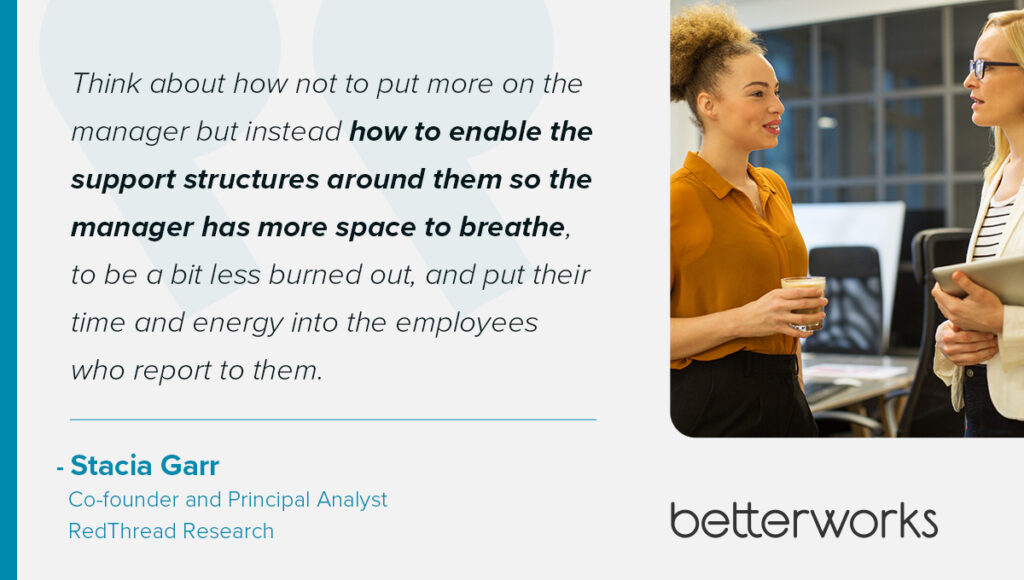
Two of the most powerful ways to drive greater manager effectiveness, Garr says, are for organizations to help employees identify the skills they need to be successful in the future and to provide resources to help employees understand how to give and receive feedback. Both involve taking work off of the manager’s plate, not adding to it.
The pressure release valve, according to Garr, will come from leveraging technology to provide a structure that enables employees to self-correct — to understand what they are responsible for and what they should expect from their managers. Such a structure involves regular conversations between managers and employees and provides both with data-based insights to help them understand team and individual performance so that they can course correct.
“Think about how not to put more on the manager but instead how to enable the support structures around them so the manager has more space to breathe, to be a bit less burned out, and put their time and energy into the employees who report to them,” Garr says.
A real-world example of a high-trust culture
Trust has a neurological component that leads to better performance and higher well-being, a concept we explain in the ebook. This is why organizations like Great Places to Work believe that trust is the best measure of culture.
I share my own experience to explain the power of a high-trust culture. The marketing team I work with at Betterworks, which is a remote-first company, is composed of very intelligent, appreciative, and experienced individuals who aim for excellence in everything they do. And while these are some of the reasons why I am thrilled to be a part of this team, they’re not why I trust my colleagues and value our work as much as I do.
I am committed to helping this team as much as possible because I like them as individuals (we all get along fabulously) and I trust them to do good work. I know they have my back, and I want them to feel they can trust me as much as I trust them. We are responsive and accountable to each other. And, I care personally about the work I do and the quality of it. I know they feel the same way about their work. Without verbally expressing it, we encourage each other to be our best.
Mind you, we don’t meet in an office regularly. Some team members meet in person in one of our co-working spaces or at occasional offsites. Oddly, though, I feel as close, if not closer, to this group than other in-person teams I have worked on. I feel the same way about others in the company. It truly is an incredible experience to work alongside fully committed people with whom I can engage as easily in a lighthearted conversation as a serious one.
The trust and transparency we have is enabled by five factors in my view: high emotional intelligence (EQ), goal-setting, clear and frequent communications, recognition, and a “no surprises” atmosphere.
High EQ: We operate in a culture that promotes psychological safety and honest communication. The ideas and opinions of every person on the team (and indeed, in the company) are valued.
Goal-setting: We each have quarterly goals and metrics that we create and manage, some of which are driven by team and organizational goals — and we can each see what others on our team (or other teams) are working on. There is complete transparency. The goals help us to prioritize what matters and make us accountable for achieving meaningful results. The trusting relationships make us accountable to one another.
Clear and frequent communications: I have check-in conversations with my manager every week to update her on my progress (she can also check my goals), problem-solve, adjust as needed, and stay on track. If I want feedback on something I’ve done from my peers or managers, I can request it at any time using a feedback template in the Betterworks platform. I also meet with various team members throughout the week via video meetings, and we can communicate anytime with our group, other groups, or individuals via Slack.
Recognition: The team — from the CMO to individual contributors — is deliberate about celebrating group accomplishments, and we share meaningful recognition and appreciation of colleagues via a Slack recognition channel.
“No surprises” atmosphere: Performance reviews are never anxiety-inducing or unpleasant because I always know where I stand. Conversations I’ve been having all along with my manager, my progress on goals, and peer feedback roll up into a quarterly performance and development conversation. This is a conversation based on a few key questions that both my manager and I respond to via the Betterworks platform and then meet to discuss. I have never felt surprised by any of the questions, nor have I felt that my reviews were unfair.
The combination of transparency, communication, and support provides a psychological safety net that allows me to be productive, effective, and happy. One way to think about fostering greater trust is through the framework of competence, character, and consistency, which we dive into in Focusing on Fairness to Close the Trust Gap.

Rethinking how to build trust in 2024
In Gartner’s 2024 HR Priorities Survey, the top three priorities selected by HR leaders to meet their organization’s goals were leader and manager development, organizational culture, and HR technology.
While these are individual priorities, they are all connected and can be addressed through the right performance management approach. Woven throughout these three is the concept of establishing high trust among employees, managers, and organizational leaders. Fair performance management processes that are supported by the right technology can strengthen the organization’s most important relationships and drive an empowered and positive culture. When managers’ time is used more effectively, they will have the bandwidth to focus on their people and develop the right skills they need to manage them properly, as well as feel less stressed in their roles.
How can you get started? Read 7 Ways to Build More Trustworthy Performance Management for actionable steps you can take to increase trust in your performance management processes.
Focusing on Fairness to Close the Trust Gap

